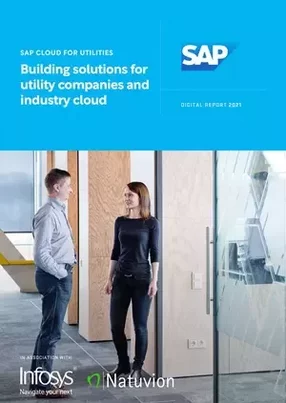Building solutions for utility companies and industry cloud
It’s appropriate that two of SAP Cloud for Utilities’ key directors are in attendance for today’s Zoom interview as the company is embracing transformation at the double. Mateu Munar, Senior Director, Industry Business Unit Utilities, and Stefan Engelhardt, Global VP Go-To-Market Strategy Industry Business Unit Utilities, spend exactly an hour talking me through all the exciting cloud developments that enable utilities to pursue new digital business models and achieve sustainable growth.
We start by focusing on solutions, reflecting on the major changes that have occurred since 2019, before discussing more exciting changes coming up.
“We started this programme a couple of years ago to bring to the market an alternative to our own on-premise offering, and go with a new proposition that addresses the new market needs,” said Munar. “We started with Utilities Retail, and the focus of the development is on the end-to-end process requirements from our customers. Even though we have different cloud solutions, a key objective of the programme is to make sure they work as one and consumed either as a whole or in a modular way. Integration is a fundamental stream in our development, integration among cloud solution and integration with S/4HANA Utilities as well.”
He proceeds to outline the new extension of SAP’s One Domain Model for Utilities, which from a data management and integration perspective, works as one orchestration layer between the individual cloud solutions, providing consistency of data and processes – what is called Cloud for Utilities Foundation. “If we get – for example – a new customer from the commerce system, the data around it is properly maintained across all the different solutions that are going to consume that data,” adds Engelhardt.
Another important focus of Cloud for Utilities is on a Market Communication solution, ensuring smooth data exchanges between distributors, retailers and meter data service providers based on the local market standards.
“We see the changing dynamics of the energy market as an opportunity for utility companies to transform into multi-service-oriented companies, and SAP provides a suite that addresses the non-commodity space with products that are complementary to traditional energy services,” added Engelhardt.
Badenova shows partnership potential
To illustrate SAP Cloud for Utilities’ desire to maximise the digital potential for all its customers, Engelhardt illustrates the work it is doing with Badenova, an innovative energy service provider and distribution grid operator in the South of Germany.
As Germany has a heterogeneous market structure, with many small municipalities that would like to offer innovative multi-service offerings but can’t afford to build their own platforms, Badenova helps plug the gap – running and operating the platform and whole logistics.
“They have created an own e-commerce platform that bundles energy services with attractive new offerings of any kind,” he says. “They are becoming themselves a service provider, leveraging our platform as backend. This White-Labeling of own IP shows the industry is going in new ways to open revenue streams, and Cloud for Utilities is designed to support those innovative business models.”
Munar says SAP is currently integrating all its relevant industry solutions in a hybrid deployment model with out-of-the box integration flows, which will be available in the first quarter of 2021, ahead of a full cloud suite being completed next year.
SAP has since completed two successful test cycle rounds for its end-to-end integrated solution.
“Two major and successful test cycles of the end-to-end processes have happened, the first one in June (2006 Release) and the second one in November (2011 Release). Tests were focused on the execution of the end-to-end scenario for selling and billing of commodity and non-commodity products and services.”
To date, it has involved 20 customers globally, from Germany, US and UK to Portugal, New Zealand, Hong Kong. “We align with them our development strategy, functionalities being developed, and they tell us their current and future needs and requirements, and they test the solutions, this will help us to build a solution that is fully aligned with the market expectations,” he added.
“One key element is that this first release will enable existing customers to easily connect their back-end solutions with cloud components, helping them capitalize on their previous SAP Industry Solutions investments. That is a key achievement and supports the end-to-end process. We are working with our customers in different pilots and co-development of the solution.”
In the Cloud space, partners are becoming more pivotal.
“We have launched a big partner enablement programme to develop together and incorporate in our end-to-end suite the solutions that partners are developing on top of our platform, we call it Industry Cloud. We will pay special attention to that in 2021, and want to have as many complementary partners as possible,” said Engelhardt.
More than ever, the role of customers as co-innovation partners is crucial for the agile development of industry-specific cloud offerings.
“E.ON and SAP announced in summer 2020 the joint development of a new cloud standard solution for the Energy Distribution Business. Thus EON is a Cloud for Utilities customer and more importantly, an important partner, co-developing market standards – the same with Badenova in the Retail space. We must ensure the scope of our solutions is meeting market demands, opening new revenue streams and securing efficiency improvements for our customers. What is clear is in this new cloud world, utility companies have multiple requirements, and we need partners to complement what we are bringing.”
Industry Cloud focus in 2021
Engelhardt anticipates two key product streams in the next 5 to 10 years. Firstly, the on-premise world, which will be deployed more and more on private cloud environments (incorporating the S/4HANA Utilities suite) and secondly, native cloud solutions that come with highly modularized architectures and simplified business processes.
The latter won’t support the same functional complexity of traditional on-premise solutions but are faster to implement and provide significant TCO advantages. “We believe most utilities will require a mix of both – at least until the majority of the traditional business processes has been fully transformed to the digital age,” he said.
“A lot of traditional business processes cannot be supported by native cloud applications unless the industry changes massively – and I don’t see that happening quickly. So having a solution strategy that supports both worlds, like S/4HANA on premise with the cloud, I think that’s very important. We can support both narratives – a complete end-to-end process on-premise and by the end of next year, a complete end-to-end in the native cloud, and any combination of both.”
Consequently, SAP’s on-premise solution will be further developed in parallel to SAP’s investment in the cloud, he added, identifying markets and segments which need it. “The good thing is we can offer the complete on-premise suite through a subscription model in a private cloud environment, leveraging hyper-scaler qualities,” he said.
Other priorities include:
- the integration of solutions around Marketing Communications, ensuring they can work with on-premise or cloud-native – taking advantage of the new One Domain Model for Utilities
- building proper meter-to-cash engine using SAP’s cloud-native solution Subscription Billing
- focusing on adoption, ensuring customers properly adopt SAP solutions, and learn how to implement systems
Engelhardt said it must simplify how customers transform from current landscapes to new ones.
“We are working on ways to automate what’s possible. When you move from an on-premise, IT environment – that was designed 10 to 15 years ago – and you go to a cloud environment, you always have a lot of change management, and technical things to consider. SAP has plenty of tools, and we’re looking to enhance them for utilities, and automate more processes.”
Asked about the industry’s future direction, Engelhardt said: “I don’t know if there’s one clear direction – beyond everyone wanting to become green, and offering more sustainable products. The trend to become customer-focused multi-service providers will definitively impact the underlying IT requirements at all Utilities.
“We see some customers saying ‘we can only achieve what we need with the most modern products’, but the majority are going step-by-step. Every company has to find the way that fits best to its strategy and we at SAP are committed to support this journey with all of our industry expertise.”




